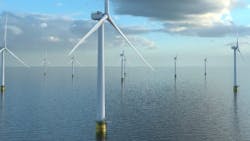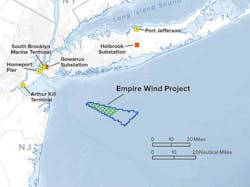Trump administration halts work on Empire Wind project
By Bruce Beaubouef, Managing Editor
The Trump administration has halted work on Equinor’s Empire Wind 1 project that had just started construction in federal waters off the coasts of New Jersey and New York; and it has ordered a comprehensive review of existing offshore wind permits.
On April 16, US Interior Secretary Doug Burgum ordered an immediate halt to construction on Empire Wind, citing “serious issues with respect to the project approvals” and the previous administration’s approval process.
A statement that Burgum issued on X said that the halt would remain in effect “until further review of information that suggests the Biden administration rushed through its approval without sufficient analysis.”
The decision follows President Donald Trump’s pause on leasing and permitting for offshore wind development on the US Outer Continental Shelf, issued back in January. While the order did not affect existing lease rights, it requires a thorough review of current wind energy leases for potential termination or amendment.
In his statement on Empire Wind, Secretary Burgum cited “information that raises serious issues with respect to the project approvals.” Aside from any potential environment or ecological impacts, there could be national security questions about offshore wind development.
Burgum’s directive follows intense pressure from Rep. Chris Smith (R-NJ), who warned that Equinor’s plans to begin construction this April were “alarming” and potentially dangerous, citing unresolved questions about radar interference, hurricane risks, and offshore collision hazards.
Smith demanded that the project be paused until the federal review is completed, warning that rushing construction would endanger “some of the nation’s busiest waters,” jeopardize FAA and national security radar systems, and put lives at risk.
He pointed to last summer’s Vineyard Wind turbine collapse off the coast of Nantucket—which scattered fiberglass and foam into the ocean—as a preview of the environmental threats Empire Wind could pose if exposed to severe weather or cargo vessel collisions.
The administration’s decision to freeze Empire Wind construction also follows a newly released Government Accountability Office (GAO) report, which validates concerns long raised by national security experts, the Department of Defense, and members of Congress.
The report found that offshore wind turbines can disrupt high-frequency and marine radar systems, compromise military readiness, obstruct flight paths during exercises, and hamper maritime navigation.
These findings affirmed earlier warnings from Rep. Smith and others that offshore wind expansion poses threats not only to defense systems but also to commercial and recreational marine traffic. “Projects like Empire Wind 1 off the coast of New Jersey and New York are dangerous and reckless,” said Rep. Smith, who called the GAO report “deeply troubling.”
The report cites a US Department of Energy assessment and a 2022 National Academies study indicating that turbines—constructed mostly from highly reflective steel—can interfere with high-frequency and marine vessel radar systems, noting that mitigation techniques for marine radar interference are still underdeveloped and unproven. The report further warned that smaller vessels may be obscured on radar, raising the risk of collisions with larger ships that cannot see or avoid them in time.
Smith has also criticized BOEM for approving projects like Atlantic Shores South despite BOEM’s own 560-page environmental review which acknowledged that the project could interfere with NORAD radar and operations at Joint Base McGuire-Dix-Lakehurst. “BOEM issued full federal approval before even formalizing a new agreement with the DOD to assess risks,” Smith said. “That’s shocking.”
Smith has been leading congressional efforts to scrutinize various offshore wind initiatives. In March 2023, he successfully introduced an amendment in the House of Representatives mandating a comprehensive GAO study of wind turbine impacts. Although the Senate blocked the amendment, Smith and other lawmakers requested the GAO investigation via letter—a move that led to the report’s publication.
Later in July, Smith authored an amendment to the FAA reauthorization bill requiring a certification that wind projects would not interfere with aviation or military radar. While it passed the House, it too was blocked in the Senate.
Observers say that this Empire Wind 1 decision marks a significant escalation in the offshore wind debate. With the GAO’s findings public and a federal review underway, future wind projects will likely face heightened scrutiny—especially near high-traffic corridors or military installations. As the national debate over offshore wind continues, the GAO report adds a new layer of complexity—one that places national security and safety at the center of the conversation.
Rep. Smith and other critics continue to call for more transparency, scientific review, and interagency coordination before any offshore wind construction resumes.
The Empire Wind 1 project, which secured over $3 billion in project financing in December 2024, was poised to become the first offshore wind project to connect into the New York City grid. With a contracted capacity of 810 megawatts, the project had been designed to power 500,000 New York homes upon its planned completion in 2027.
Combined with the redevelopment of the South Brooklyn Marine Terminal, which is being transformed into the nation’s largest dedicated port facility for offshore wind, the project was expected to create more than 1,000 union jobs during the construction phase. The terminal was designated to serve as both the operations and maintenance hub for Empire Wind 1 and the site of the project’s onshore substation.
The total capital investment for Empire Wind 1, including fees for the South Brooklyn Marine Terminal, was previously estimated at approximately $5 billion, factoring in expected future tax credits.
The development history of Empire Wind dates back to 2017 when Equinor first acquired the lease area. In June 2024, the company had secured a 25-year Purchase and Sale Agreement with the New York State Energy Research and Development Authority at a strike price of $155.00/MWh.
The move from the Trump Administration represents a significant departure from the Biden administration’s ambitious offshore wind initiatives, which had targeted 30 gigawatts of offshore wind capacity by 2030 and 15 gigawatts of floating offshore wind by 2035.
New York Governor Kathy Hochul Governor expressed her opposition to the decision. “As Governor, I will not allow this federal overreach to stand,” Hochul said. “I will fight this every step of the way to protect union jobs, affordable energy and New York’s economic future.”
The Oceantic Network, a trade group dedicated to growing the US offshore renewable energy industry and its supply chain, released a statement from Liz Burdock, its president and CEO: “Stopping work on the fully federally permitted Empire Wind 1 offshore project should send chills across all industries investing in and holding contracts with the United States Government. Preventing a permitted and financed energy project from moving forward sends a loud and clear message to all businesses – beyond those in the offshore wind industry – that their investment in the US is not safe. We urge the Department of Interior to lift this order immediately to restore a predictable and equitable environment for the buildout of critical energy resources that help secure our energy future and independence.”
Empire Offshore Wind LLC says that it will “safely halt” the offshore construction in waters of the outer continental shelf for the Empire Wind project, in accordance with the halt work order issued by the US government.
A statement on Equinor’s website says that “Empire is engaging with relevant authorities to clarify this matter and is considering its legal remedies, including appealing the order.”
But the statement added that “Empire is complying with the order affecting project activities for Empire Wind. Upon receipt of the order, immediate steps were taken by Empire and its contractors to initiate suspension of relevant marine activities, ensuring the safety of workers and the environment.”
About the Author
Bruce Beaubouef
Managing Editor
Bruce Beaubouef is Managing Editor for Offshore magazine. In that capacity, he plans and oversees content for the magazine; writes features on technologies and trends for the magazine; writes news updates for the website; creates and moderates topical webinars; and creates videos that focus on offshore oil and gas and renewable energies. Beaubouef has been in the oil and gas trade media for 25 years, starting out as Editor of Hart’s Pipeline Digest in 1998. From there, he went on to serve as Associate Editor for Pipe Line and Gas Industry for Gulf Publishing for four years before rejoining Hart Publications as Editor of PipeLine and Gas Technology in 2003. He joined Offshore magazine as Managing Editor in 2010, at that time owned by PennWell Corp. Beaubouef earned his Ph.D. at the University of Houston in 1997, and his dissertation was published in book form by Texas A&M University Press in September 2007 as The Strategic Petroleum Reserve: U.S. Energy Security and Oil Politics, 1975-2005.


